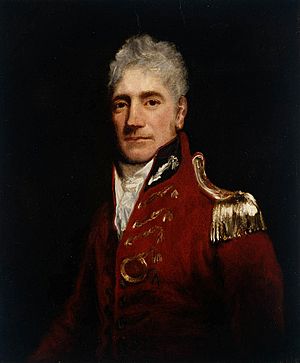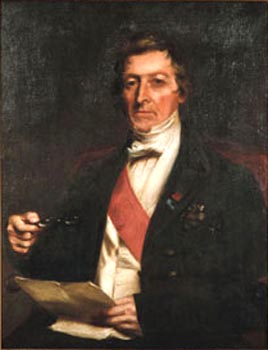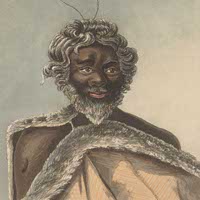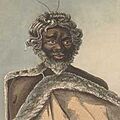Bathurst War facts for kids
Quick facts for kids Bathurst War |
|||||||
|---|---|---|---|---|---|---|---|
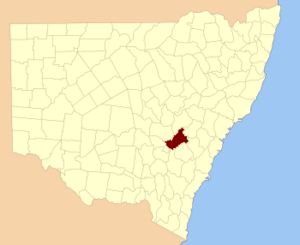 The Bathurst county in which the war was fought |
|||||||
|
|||||||
| Belligerents | |||||||
| Wiradjuri | |||||||
| Commanders and leaders | |||||||
| Windradyne | |||||||
| Strength | |||||||
| 1,500 (unable to verify) | |||||||
| Casualties and losses | |||||||
| ~20 killed others wounded |
~100 killed others wounded |
||||||
The Bathurst War was a conflict that happened in 1824. It was fought between the Wiradjuri people, who are Indigenous Australians, and the British. This war started after British settlers began moving into the fertile lands west of the Blue Mountains.
This expansion happened because explorers found a way through the mountains in 1813. At first, not many settlers moved there. But when Governor Thomas Brisbane took charge, he allowed many people to claim land. This huge number of new settlers put a lot of pressure on the Wiradjuri people. Their traditional food sources became scarce, and important cultural sites were disturbed. By early 1824, fighting broke out. The Wiradjuri used a style of fighting called guerrilla warfare, where they made quick attacks and then disappeared. Governor Brisbane declared martial law (military rule), and the Wiradjuri resistance ended later that year.
Contents
Why the War Started: The Background Story
Crossing the Blue Mountains
For many years, people tried to cross the Blue Mountains. But it was very difficult. In May 1813, three explorers named Gregory Blaxland, William Lawson, and William Charles Wentworth finally found a way. After traveling for 21 days, they reached Mount Blaxland. From there, they saw huge areas of forest and grass. Blaxland thought this land could support the colony's animals for 30 years.
This land was actually the home of the Wiradjuri people. They are one of the largest Indigenous language groups in Australia. Their territory stretched from the Blue Mountains in the east to the grassy plains in the west. The Wiradjuri groups, including those led by Windradyne, were connected by language, culture, and trade.
Governor Lachlan Macquarie's Approach
After the mountains were crossed, explorer George Evans explored further. He reported that the land was excellent for farming. So, Governor Lachlan Macquarie ordered a road to be built from the Nepean River. The road was 100 miles (160 km) long and was finished in less than six months. Governor Macquarie then traveled to see the new country.
When he arrived in the area that would become Bathurst, seven Wiradjuri people watched his welcoming ceremony. Macquarie wrote that they seemed surprised and a little scared at first. But they soon became friendly. He described them as "inoffensive and cleanly." He even traded a piece of yellow cloth for a Wiradjuri man's possum-skin cloak. Some people think this man might have been Windradyne, but we can't be sure.
In 1820, the town of Bathurst only had 114 people. Governor Macquarie was careful about new settlements. He had seen conflicts before, like the Hawkesbury and Nepean Wars. So, he wanted to avoid new fighting. During his time, relations with the Wiradjuri were peaceful.
Governor Thomas Brisbane's Changes
In December 1821, Governor Macquarie left his job. His replacement was Governor Thomas Brisbane. Governor Brisbane had different ideas. He changed the laws about land settlement. This led to many British settlers moving across the Blue Mountains.
This large number of new settlers put a huge strain on the Wiradjuri lands. Their traditional food sources were damaged, and important cultural sites were destroyed. In response, the Wiradjuri began to resist. They knew they couldn't win a direct fight against guns. So, they used guerrilla tactics, attacking small, unprotected settler outposts.
Key Events of the War
The Potato Field Incident
In early 1824, near Bathurst, a farmer offered some potatoes to a group of Wiradjuri people. The next day, Wiradjuri families returned to the field. They didn't understand the idea of private land ownership. So, they started taking more potatoes. The farmer then shot at the group. Some Wiradjuri people were hurt or killed.
Windradyne was one of the survivors. He was very angry about the attack. He and his warriors immediately started attacking nearby settler stations. One settler described how Windradyne and his group surrounded their hut. The settler's son, who was 18, bravely spoke to them. The Wiradjuri warriors left without harming them. But they later attacked another settler's place nearby.
Revenge Attacks and Rising Tension
Similar attacks happened at other places. Settlers were speared, weapons were stolen, buildings were burned, and animals were killed. While Windradyne fought in the north-east, other Wiradjuri groups attacked in the south. They scared settlers and drove away their cattle.
In response, groups of armed settlers also formed. They attacked and killed three Wiradjuri women. For several months, the Wiradjuri continued their attacks. They struck in unexpected places and then disappeared back into the bush. By August 1824, a newspaper called the Sydney Gazette said the situation was very serious for the colony.
Martial Law is Declared
On August 14, Governor Brisbane declared martial law. This meant the military took control instead of the usual laws. Governor Brisbane said that the Wiradjuri attacks were hurting settlers and their property. He also said that normal police powers had failed. He hoped that using military force would stop the fighting. He also reminded everyone that cruelty was never allowed, and that women and children should be spared.
A group of 75 British soldiers, led by Major James Morisset, was sent to Bathurst. Local settlers also joined them. The soldiers tried to bring order and enforce martial law. But these efforts didn't have much effect. One historian said that the Wiradjuri didn't understand what martial law meant.
The Wiradjuri continued their attacks. There were many small fights. Settlers often retaliated, especially when Wiradjuri warriors tried to bury their dead. However, most of the Wiradjuri people killed during this time were not fighters. They were killed by armed settler groups or by poisoned food. In October, the Sydney Gazette said that Bathurst was in an "exterminating war."
The Battle of Bathurst
A major fight, sometimes called the Battle of Bathurst, began on September 10. A Wiradjuri group attacked a station on the Cudgegong River. They drove away cattle. Station workers chased them. The Wiradjuri then ambushed the workers, and three Wiradjuri warriors were shot.
The next day, the workers returned. They found the Wiradjuri camp empty because the warriors were burying their dead. Most of their weapons were left behind and destroyed. When the Wiradjuri returned to their camp, the station workers fired on them. At least sixteen Wiradjuri warriors were killed, and many more were wounded.
Peace Returns
When martial law was declared, the Wiradjuri were told that the fighting would continue until their leaders surrendered. There was even a reward offered for Windradyne. By late 1824, many Wiradjuri people were surrendering. But Windradyne continued to avoid capture. Because of this, martial law stayed in place for another seven weeks.
Finally, on December 11, 1824, martial law was ended. On December 28, Windradyne appeared with his people at the Governor's annual feast in Parramatta. He wore the word "peace" on his hat. The British couldn't arrest him there because so many Indigenous people were present, and it could have caused a riot.
The Sydney Gazette described Windradyne as a very impressive person. They said he was strong and had a "noble looking countenance and piercing eye." They called him "the most manly native we have ever beheld."
What Happened After the War
On December 13, 1824, Governor Brisbane thanked Major J.T. Morisset for his work. He said that the Wiradjuri had learned to respect British power. He also suggested that if Indigenous people were harmed, they should be offered payment. He set aside £50 for this purpose and for rewards to Indigenous people who helped the police.
Colonel William Stewart, who was in charge of the NSW Police, also played a role. As a reward, he was given a large piece of land (3200 acres) near Bathurst. This land included rights to the Macquarie River. Today, the wealth from this land grant can still be seen in Abercrombie House, which was built on it.
After the war, the government realized they needed a special police force that could move quickly. Foot soldiers were not effective on the wide plains. So, in 1825, Colonel Stewart created the New South Wales Mounted Police. This force was made up of soldiers, not civilians. Two groups were stationed in Bathurst and Maitland. For the next 15 years, the NSW Mounted Police became very important in enforcing British rule on the frontier.
Images for kids


